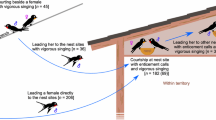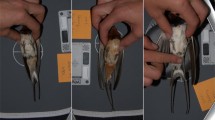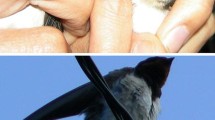Abstract
Some sexual selection models envisage exaggerated male secondary sexual characters to be costly and therefore reliable indicators of the quality of potential mates to choosy females. If male secondary sexual characters have a natural selection cost, they may be linked to each other by reciprocally constraining relationships that would prevent individual males from increasing their level of multiple signaling. Barn swallow (Hirundo rustica) males have at least two costly signals relevant to socio-sexual interactions: tail length and song. Under the hypothesis that a trade-off exists between male signals, we manipulated the maintenance cost of tail ornaments to test whether this reduced the quantity and quality of song, a condition-dependent, phenotypically plastic signal. Contrary to our expectation, tail elongation had no effect on singing activity and song complexity. However, tail-elongated males produced songs with longer terminal parts ('rattles'). Long rattles are associated with highly competitive social contexts and high circulating levels of testosterone, suggesting that tail-elongated males were more frequently involved in either male-male aggressive or inter-sexual interactions. Therefore, this study shows that males are not displaying multiple signals at the maximum possible level, implying that this system is open to unreliable communication. However, long-term trade-offs between signal expression and viability may prevent males from displaying both signals at higher rates.



Similar content being viewed by others
References
Andersson M (1986) Evolution of condition-dependent sex ornaments and mating preferences: sexual selection based on viability differences. Evolution 40:804–820
Andersson M (1994) Sexual selection. Princeton University Press, Princeton, NJ
Eberhardt LS (1994) Oxygen consumption during singing by male Carolina wrens (Thryothorus ludovicianus). Auk 111:124–130
Falconer DS (1981) Introduction to quantitative genetics. Longman, London
Galeotti P, Saino N, Sacchi R, Møller AP (1997) Song correlates with social context, testosterone and body condition in male barn swallows. Anim Behav 53:687–700
Grafen A (1990) Sexual selection unhandicapped by the Fisher process. J Theor Biol 144:517–546
Heywood JS (1989) Sexual selection by the handicap mechanism. Evolution 43:1387–1397
Horn AG, Leonard ML, Weary DM (1995) Oxygen consumption during crowing by roosters: talk is cheap. Anim Behav 50:1171–1175
Iwasa Y, Pomiankowski A (1994) The evolution of mate preferences for multiple sexual ornaments. Evolution 48:853–867
Iwasa Y, Pomiankowski A, Nee S (1991) The evolution of costly mate preferences. II. The "handicap" principle. Evolution 45:1431–1442
Johnstone RA (1995). Honest advertisement of multiple qualities using multiple signals. J Theor Biol 177:87–94
Lambrechts M, Dhondt AA (1988) The anti-exhaustion hypothesis: a new hypothesis to explain song performance and song switching in the great tit. Anim Behav 36:327–334
Møller AP (1987) Social control of deception among status signalling house sparrows Passer domesticus. Behav Ecol Sociobiol 20:307–311
Møller AP (1988) Female choice selects for male sexual tail ornaments in the monogamous barn swallow. Nature 332:640–642
Møller AP (1989) Viability costs of male tail ornaments in a swallow. Nature 339:132–135.
Møller AP (1990) Male tail length and female mate choice in the monogamous swallow (Hirundo rustica). Anim Behav 39:458–465
Møller AP (1991a) Parasites, sexual ornaments, and mate choice in the barn swallow. In: Loye J, Zuk M (eds) Bird-parasite interactions: ecology, evolution and behaviour. Oxford Univ Press, Oxford, pp 328–348
Møller AP (1991b) Viability is positively related to degree of ornamentation in male swallows. Proc R Soc Lond B 243:145–148
Møller AP (1991c) Parasite load reduces song output in a passerine bird. Anim Behav 41:723–730
Møller AP (1993) Female preference for apparently symmetrical male sexual ornaments in the barn swallow Hirundo rustica. Behav Ecol Sociobiol 32:371–376
Møller AP (1994) Sexual selection and the barn swallow. Oxford University Press, Oxford
Møller AP, de Lope F (1994) Differential costs of a secondary sexual character: An experimental test of the handicap principle. Evolution 48:1676–1683
Møller AP, Pomiankowski A (1993) Why have birds got multiple sexual ornaments? Behav Ecol Sociobiol 32:167–176
Møller AP, de Lope F, Saino N (1995a) Sexual selection in the barn swallow Hirundo rustica. Aerodynamic adaptations. J Evol Biol 8:671–687
Møller AP, de Lope F, Lopez Caballero JM (1995b) Foraging costs of a tail ornament: Experimental evidence from two populations of barn swallows Hirundo rustica with different degrees of sexual size dimorphism. Behav Ecol Sociobiol 37:289–295
Møller AP, Saino N, Taramino G, Galeotti P, Ferrario S (1998) Paternity and multiple signaling: effects of a secondary sexual character and song on paternity in the barn swallow. Am Nat 151:236–242
Omland KE (1996a) Female mallard mating preferences for multiple male ornaments. I. Natural variation. Behav Ecol Sociobiol 39:353–360
Omland KE (1996b) Female mallard mating preferences for multiple male ornaments. II. Experimental variation. Behav Ecol Sociobiol 39:361–366
Rohwer S (1977) Status signaling in Harris sparrows: Some experiments in deception. Behaviour 61:107–129
Rohwer S, Rohwer FC (1978) Status signalling in Harris sparrows: experimental deceptions achieved. Anim Behav 26:1012–1022
Rowe C (1999) Receiver psychology and the evolution of multi-component signals. Anim Behav 58:921–931
Rubolini D, Schiavi M (2002) Tail length correlates with fat stores in pre-migratory roosting barn swallows Hirundo rustica, Ardea 90:121–127
Saino N, Møller AP (1994) Secondary sexual characters, parasites and testosterone in the barn swallow Hirundo rustica. Anim Behav 48:1325–1333
Saino N, Møller AP (1995) Testosterone correlates of mate-guarding, singing and aggressive behaviour in male barn swallows (Hirundo rustica). Anim Behav 49:465–472
Saino N, Møller AP (1996) Sexual ornamentation and immunocompetence in the barn swallow. Behav Ecol 7:227–232
Saino N, Møller AP, Bolzern AM (1995) Testosterone effects on the immune system and parasite infestations in the barn swallow (Hirundo rustica): an experimental test of the immuno-competence hypothesis. Behav Ecol 6:397–404
Saino N, Bolzern AM, Møller AP (1997a) Immunocompetence, ornamentation and viability of male barn swallows (Hirundo rustica). Proc Natl Acad Sci USA 94:549–552
Saino N, Cuervo JJ, Krivacek M, de Lope F, Møller AP (1997b) Experimental manipulation of tail ornament size affects haematocrit of male barn swallows (Hirundo rustica). Oecologia 110:186–190
Saino N, Galeotti P, Sacchi R, Møller AP (1997c) Song and immunological condition in male barn swallows (Hirundo rustica). Behav Ecol 8:364–371
Saino N, Primmer CR, Ellegren H, Møller AP (1997d) An experimental study of paternity and tail ornamentation in the barn swallow (Hirundo rustica). Evolution 51:562–570
Saino N, Calza S, Ninni P, Møller AP (1999) Barn swallows trade survival against offspring condition and immunocompetence. J Anim Ecol 68:999–1009
Saino N, Bertacche V, Ferrari RP, Martinelli R, Møller AP, Stradi R (2002a) Carotenoid concentration in barn swallow eggs is influenced by laying order, maternal infection and paternal ornamentation. Proc R Soc Lond B 269:1729–1733
Saino N, Ferrari RP, Martinelli R, Romano M, Rubolini D, Møller AP (2002b) Early maternal effects mediated by immunity depend on sexual ornamentation of the male partner. Proc R Soc Lond B 269:1005–1009
Saino N, Incagli M, Martinelli R, Møller AP (2002c) Immune response of male barn swallows in relation to parental effort, corticosterone plasma levels, and sexual ornamentation. Behav Ecol 13:169–174
Specht R (2001) AvisoftSAS LabPro, sound analysis and synthesis laboratory: a PC-software for Ms-Windows users' guide. http://home.t-online.de/home/raimund.specht/upd39.exe. Cited 5 May 2003
Vehrencamp SL, Bradbury JW, Gibson RM (1989) The energetic cost of display in male sage grouse. Anim Behav 38:885–898
Wingfield JC, Ball GF, Dufty AM Jr, Hegner RE, Ramenofsky M (1987) Testosterone and aggression in birds. Am Sci 75:602–608
Zahavi A (1975) Mate selection: a selection for a handicap. J Theor Biol 53:205–214
Zahavi A (1977) The cost of honesty (further remarks on the handicap principle). J Theor Biol 67:603–605
Zuk M, Thornhill R, Ligon J, Johnson K, Austad K, Ligon SH, Thornhill NW, Costin C (1990) The role of male ornaments and courtship behavior in female mate choice of red jungle fowl. Am Nat 136:459–473
Acknowledgements
This study was supported by MURST COFIN2000 and COFIN2001 grant to N.S. and P.G. The experiments complied with current Italian law.
Author information
Authors and Affiliations
Corresponding author
Additional information
Communicated by: M. Webster
Rights and permissions
About this article
Cite this article
Saino, N., Romano, M., Sacchi, R. et al. Do male barn swallows (Hirundo rustica) experience a trade-off between the expression of multiple sexual signals?. Behav Ecol Sociobiol 54, 465–471 (2003). https://doi.org/10.1007/s00265-003-0642-z
Received:
Revised:
Accepted:
Published:
Issue Date:
DOI: https://doi.org/10.1007/s00265-003-0642-z




